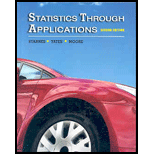
Concept explainers
a)
To show that the 95% confidence interval for p is correct.
a)
Answer to Problem 9.42E
The 95% confidence interval is correct.
Explanation of Solution
Given:
n = 2372
Confidence level = 0.95
Formula:
Sample proportion:
Margin of error:
Calculation:
Sample proportion,
Now need to find Zc
The level of significance is = a =0.05
Therefore, Zc = Z a/2 = 1.96 ..Using standard normal table
The margin of error is,
Therefore, sample proportion is 81% and margin of error is 1.6%, hence 95% confidence interval is correct.
b)
To explain whether the stations conclusion is not justified.
b)
Answer to Problem 9.42E
The station's conclusion is not justified.
Explanation of Solution
(b) The sample is not a random sample as the sample is a call-in poll. Therefore, the station's conclusion is not justified. This means that people will have to voluntary call in their response, making the sample a voluntary response sample. People with the strongest believes tend to participate in a voluntary response sample and thus the sample will not be representative for the population.
However, the sample will result from nonresponse bias, because not everybody who hears/reads about the poll will actually call in their opinion.
Chapter 9 Solutions
Statistics Through Applications
Additional Math Textbook Solutions
Elementary Statistics: Picturing the World (6th Edition)
STATS:DATA+MODELS-W/DVD
Intro Stats, Books a la Carte Edition (5th Edition)
Essentials of Statistics (6th Edition)
Basic Business Statistics, Student Value Edition
 MATLAB: An Introduction with ApplicationsStatisticsISBN:9781119256830Author:Amos GilatPublisher:John Wiley & Sons Inc
MATLAB: An Introduction with ApplicationsStatisticsISBN:9781119256830Author:Amos GilatPublisher:John Wiley & Sons Inc Probability and Statistics for Engineering and th...StatisticsISBN:9781305251809Author:Jay L. DevorePublisher:Cengage Learning
Probability and Statistics for Engineering and th...StatisticsISBN:9781305251809Author:Jay L. DevorePublisher:Cengage Learning Statistics for The Behavioral Sciences (MindTap C...StatisticsISBN:9781305504912Author:Frederick J Gravetter, Larry B. WallnauPublisher:Cengage Learning
Statistics for The Behavioral Sciences (MindTap C...StatisticsISBN:9781305504912Author:Frederick J Gravetter, Larry B. WallnauPublisher:Cengage Learning Elementary Statistics: Picturing the World (7th E...StatisticsISBN:9780134683416Author:Ron Larson, Betsy FarberPublisher:PEARSON
Elementary Statistics: Picturing the World (7th E...StatisticsISBN:9780134683416Author:Ron Larson, Betsy FarberPublisher:PEARSON The Basic Practice of StatisticsStatisticsISBN:9781319042578Author:David S. Moore, William I. Notz, Michael A. FlignerPublisher:W. H. Freeman
The Basic Practice of StatisticsStatisticsISBN:9781319042578Author:David S. Moore, William I. Notz, Michael A. FlignerPublisher:W. H. Freeman Introduction to the Practice of StatisticsStatisticsISBN:9781319013387Author:David S. Moore, George P. McCabe, Bruce A. CraigPublisher:W. H. Freeman
Introduction to the Practice of StatisticsStatisticsISBN:9781319013387Author:David S. Moore, George P. McCabe, Bruce A. CraigPublisher:W. H. Freeman





